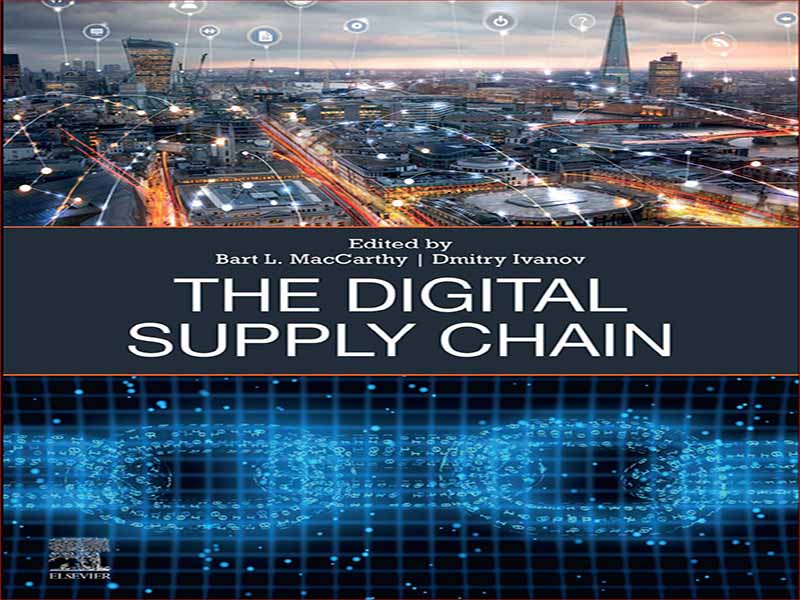- عنوان کتاب: The Digital Supply Chain
- نویسنده: Bart L. MacCarthy
- حوزه: سرویس دیجیتال,زنجیره تامین
- سال انتشار: 2022
- تعداد صفحه: 466
- زبان اصلی: انگلیسی
- نوع فایل: pdf
- حجم فایل: 9.95 مگابایت
دیجیتالی شدن یکی از چشمگیرترین و تأثیرگذارترین روندهای بزرگ است که در تجارت، صنعت و تجارت رخ می دهد. فنآوریها، سیستمها و پلتفرمهای دیجیتال بر نحوه همکاری و تبادل اطلاعات در سراسر زنجیره تأمین و نحوه ادغام، مدیریت و کنترل عملیات زنجیره تأمین تأثیر میگذارند. دیجیتالی شدن به طور بالقوه یک رشته دیجیتال قوی را قادر می سازد که کل زنجیره تامین فیزیکی را به هم متصل کند. زنجیره تامین دیجیتال تاثیر دیجیتالی شدن بر طراحی، مدیریت و کنترل زنجیره های تامین معاصر و آینده را به طور عمیق مورد بررسی و تجزیه و تحلیل قرار می دهد. در فصل 1، مک کارتی و ایوانف یک نمای کلی از فنآوریها و سیستمهای اصلی ارائه میدهند که بیشترین امید را در پیوند دادن دنیای مجازی و فیزیکی برای بهبود عملکرد زنجیره تامین ارائه میکنند. اینها شامل کارخانههای هوشمند، انبارهای هوشمند، لجستیک هوشمند، سیستمهای مبتنی بر ابر و پلتفرمهای دیجیتال و همچنین موتورهای محاسباتی مجهز به آنالیز، علم داده و هوش مصنوعی است. فناوریهای نوظهوری که احتمالاً بر زنجیرههای تأمین آینده تأثیر میگذارند نیز مورد بحث قرار میگیرند، از جمله بلاک چین، دوقلوهای دیجیتال، اینترنت اشیا، 5G، Edge و محاسبات مه. این فصل یک طیف در حال تکامل را از زنجیرههای تامین دیجیتالی نابالغ تا دیجیتالی فعال و تبدیلشده دیجیتالی توصیف میکند. اثرات دگرگونکننده دیجیتالیسازی زنجیرههای تامین بر سیستمهای تامین به روشهای مختلف تاثیر میگذارد که نه تنها فرصتهای جدید بسیاری را فراهم میکند، بلکه باعث ایجاد چالشهای زیادی در اکوسیستمهای زنجیره تامین غنی از دادهها میشود. فصلهای باقیمانده کتاب همه موضوعات مورد بحث در فصل مقدماتی را توسعه، گسترش و تحلیل انتقادی میدهد. در بخش دوم کتاب، فصلهای 2e8 بلوکهای سازنده و فنآوریهای توانمند برای زنجیره تامین دیجیتال را توصیف، تحلیل و ارزیابی انتقادی میکنند. در فصل 3، مورتزیس، آنجلوپولوس، و پانوپولوس سیر تکامل تولید دیجیتال را از کاربردهای اولیه رایانهها در صنعت تا اکوسیستمهای تولید هوشمند دیجیتالی امروزی ترسیم میکنند. آنها مؤلفههای کلیدی، چارچوبها و معماریهای کارخانه هوشمند، سنگ بنای Industry 4.0 (I4.0) و چالشهای قابلیت همکاری که ارائه میدهد را برجسته میکنند. در فصل 4، وینکلهاوس و گروس از یک لنز اجتماعی-تکنیکی برای درک و تجزیه و تحلیل ترکیبی از اجزای انسانی و تکنولوژیکی مورد نیاز در سیستمهای انبارداری هوشمند معاصر استفاده میکنند. در فصل 5، بازیاد، کیوانفر و کینرا به بررسی پارادایم نوظهور اینترنت اشیا و فناوری های پشتیبانی کننده آن می پردازند که پتانسیل تسهیل ساخت هوشمند و فعال کردن زنجیره های تامین دیجیتال آینده را دارند. در فصل 6، ژانگ، مک کارتی و ایوانوف، پیشرفتهای محاسباتی کلیدی را بررسی میکنند که زنجیره تامین دیجیتال را زیربنا و فعال میکند و پتانسیل تغییر زنجیرههای تامین آینده، یعنی ابر، پلتفرمها و دوقلوهای دیجیتال را دارد. در فصل 7، Brusset، La Torre و Broekaert رویکردهای محاسباتی، الگوریتمها، تجزیه و تحلیل، و هوش مصنوعی را معرفی میکنند که میتوانند برای پایهریزی تصمیمگیری زنجیره تامین مبتنی بر داده استفاده شوند. در فصل 7، پتیت، وانگ و برسفورد تأثیر دیجیتالی شدن بر بخش لجستیک را ردیابی میکنند و در مورد اینکه چگونه لجستیک با قابلیت دیجیتالی میتواند شفافیت زنجیره تأمین، کارایی عملیاتی و پاسخگویی را بهبود بخشد، بحث میکنند. در فصل 8، Treiblmaier، Rejeb، و احمد محرکها، بازدارندهها و کاربردهای صنعتی یکی از نمادینترین فناوریهای دیجیتال را بررسی میکنند که قرار است بر مدیریت و کنترل زنجیرههای تامین آینده به نام Blockchain تأثیر بگذارد. بخش سوم کتاب، فصلهای 9 و 13، به فرصتها و چالشهای موجود در مدیریت زنجیره تامین دیجیتال میپردازد. در فصل نهم، سپناکی، کارافیلی و دسپودی چالشهای مهم در تضمین کیفیت دادهها و دستیابی به حاکمیت دادههای مؤثر در معماریهای داده مشترک را که با دیجیتالی شدن زنجیره تأمین همراه است، تحلیل میکنند. در فصل 10، چان یکی از غالبترین چالشهای مدیریت زنجیره تامین – قابلیت ردیابی – را در نظر میگیرد و چگونگی طراحی سیستمهای دیجیتال قوی را برای اطمینان از ردیابی و ردیابی محصولات در سراسر زنجیره تامین مورد بحث قرار میدهد. در فصل 11، کاکس تکامل پشتیبانی دیجیتال را برای فعالیتهای معمول و استراتژیک در خرید و تدارکات، یکی از حیاتیترین عملکردهای مدیریت زنجیره تامین، بررسی میکند. در فصل 12، Jha، Verma و Bose از دیدگاه پردازش اطلاعات برای بررسی فرصت ها و رویکردهای اندازه گیری و مدیریت عملکرد در زنجیره تامین دیجیتال استفاده می کنند. در فصل 13، چا وضعیت دانش در مورد امنیت سایبری زنجیره تامین را از منظر شاغل و دانشگاهی بررسی میکند و راهنمایی برای شناسایی و دفاع در برابر بسیاری از آسیبپذیریهای بالقوه در رابط دنیای دیجیتال و فیزیکی ارائه میکند. بسیاری از فصلهای کتاب نمونههای مفصلی از تمرین را ارائه میکنند. بخش 4، شامل فصل 14e20، به بررسی دیجیتالی شدن زنجیره تامین در شش بخش مهم تجاری و صنعتی می پردازد.
Digitalization is one of the most dramatic and impactful megatrends occurring across business, industry, and commerce. Digital technologies, systems, and platforms are affecting how we collaborate and exchange information across a supply chain, and how we integrate, manage, and control supply chain operations. Digitalization potentially enables a strong digital thread connecting an entire physical supply chain. The Digital Supply Chain examines and analyzes in depth the impact of digitalization on the design, management, and control of contemporary and future supply chains. In Chapter 1, MacCarthy and Ivanov provide an overview of the principal technologies and systems that offer the most promise in linking the virtual and physical worlds to improve supply chain performance. These include smart factories, smart warehouses, smart logistics, cloud-based systems, and digital platforms, as well as the computational engines powered by Analytics, Data Science and Artificial Intelligence. Emerging technologies likely to influence future supply chains are also discussed, including Blockchain, Digital Twins, Internet of Things, 5G, Edge, and Fog computing. The chapter describes an evolving spectrum from digitally immature to digitally enabled and digitally transformed supply chains. The transformative effects of the digitalization of supply chains will affect supply systems in diverse ways providing not only many new opportunities but also giving rise to many challenges in data rich supply chain ecosystems. The remaining chapters of the book develop, expand, and critically analyze all of the themes discussed in the introductory chapter. In the second part of the book, Chapters 2e8 describe, analyze, and critically appraise the building blocks and enabling technologies for the digital supply chain. In Chapter 3, Mourtzis, Angelopoulos, and Panopoulos chart the evolution of digital manufacturing from the early applications of computers in industry to today’s digitally rich Smart Manufacturing ecosystems. They highlight the key components, frameworks, and architectures of the Smart Factory, a cornerstone for Industry 4.0 (I4.0), and the interoperability challenges it presents. In Chapter 4, Winkelhaus and Grosse apply a sociotechnical lens to understand and analyze the combination of human and technology components needed in contemporary Smart Warehousing systems. In Chapter 5, Baziyad, Kayvanfar, and Kinra examine the emerging IoT paradigm and its supporting technologies that have the potential to facilitate smart manufacturing and enable future Digital Supply Chains. In Chapter 6, Zhang, MacCarthy and Ivanov review key computing advances that underpin and enable the Digital Supply Chain and have the potential to transform future supply chains, namely, the Cloud, Platforms, and Digital Twins. In Chapter 7, Brusset, La Torre and Broekaert introduce the computational approaches, algorithms, analytics, and AI that can be harnessed to underpin data-driven supply chain decision-making. In Chapter 7, Pettit, Wang, and Beresford trace the impact of digitalization on the logistics sector and discuss how digitally enabled logistics can improve supply chain transparency, operational efficiency, and responsiveness. In Chapter 8, Treiblmaier, Rejeb, and Ahmed review the drivers, inhibitors, and industrial applications of one of the most iconic digital technologies that is set to influence the management and control of future supply chainsdthe Blockchain. The third part of the book, Chapters 9e13, addresses opportunities and challenges in the management of the Digital Supply Chain. In Chapter 9, Spanaki, Karafili, and Despoudi analyze the significant challenges in ensuring data quality and achieving effective data governance in the shared data architectures that accompany the digitalization of the supply chain. In Chapter 10, Chan considers one of the most dominant supply chain management challengesdtraceabilitydand discusses how to design robust digital systems to ensure products can be traced and tracked across the supply chain. In Chapter 11, Cox examines the evolution of digital support for both routine and strategic activities in purchasing and procurement, one of the most critical supply chain management functions. In Chapter 12, Jha, Verma, and Bose use an information processing perspective to examine opportunities and approaches for measuring and managing performance in the Digital Supply Chain. In Chapter 13, Cha reviews the state of knowledge on Supply Chain Cyber Security from both practitioner and academic perspectives, providing guidance for detection and defense against the many potential vulnerabilities at the interface of the digital and physical worlds. Many chapters throughout the book provide detailed examples of practice. Part 4, encompassing Chapters 14e20, examines digitalization of the supply chain in six important business and industrial sectors.
این کتاب را میتوانید از لینک زیر بصورت رایگان دانلود کنید:
Download: The Digital Supply Chain




































نظرات کاربران